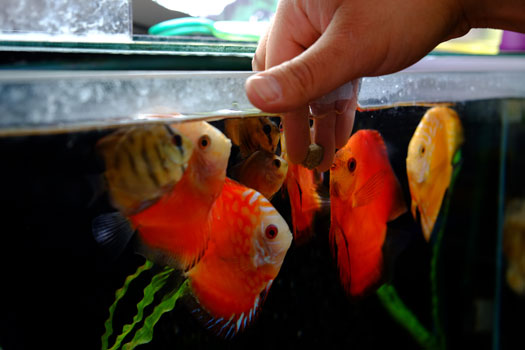- Your shopping cart is empty!
How Do You Know if the Fish in Your Aquarium Are Hungry?

Keeping fish is very similar to keeping common household pets such as canines and felines, at least in terms of nutrition and feeding habits. Even if you only have an aquarium stocked with plants and invertebrates such as ghost shrimp, these are organic species that require nourishment not just to survive but also to stay healthy and thrive in their aquatic habitat. Feeding of aquarium species is entirely up to fish keepers. Most newcomers stick with the recommendations they get from an aquarium supplier, but these may need to be adjusted as more fish are introduced or as they grow. Aside from paying attention to feeding schedules, there are other ways to determine if your fish are in need of more nourishment.
Behavior of Underfed Fish
Marine biologists know better than to constantly monitor fish when they eat because it’s easy to fall under the false impression that they never stop. In reality, fish will eat until they’re fully satisfied, but they may take their time based on the amount of flakes floating on the surface and around the tank. Once you notice fish picking at the substrate or behind plants, this is a sign they’re looking for food. The exception in this case would be scavengers and bottom feeders such as Plecostomus and shrimp. Overly aggressive feeding behavior may also suggest the fish aren’t getting enough food.
When Fish Go After Plants
It’s normal for herbivorous and omnivorous fish to nibble at plants. They may do this for the purpose of introducing some variety to their diets. If you see species such as gouramis and rainbow sharks trying to rip plants apart, this is a sign that they’re really hungry. In some cases, they may even pick at algae growth on tubes, decorations, rocks, and gravel, but this isn’t adequate nutrition for many species.
Aquarium Feeding Frequency
For most tropical freshwater species, two daily feedings are more than enough. In fact, you can feed them the right amount once a day and most fish will adjust easily because this is how resilient they are. If your tank is stocked with herbivores, more frequent feedings are recommended unless you plant aquarium grass. To this effect, automatic tank feeders are highly recommended. In saltwater reef tanks, feeding schedules tend to be more frequent, but the amounts need to be more precise because you don’t want to end up with waste that can break down into nitrates.
The Problem with Overfeeding
As previously mentioned, fish usually stop eating when they’re full, but some species won’t have problems overindulging, and they’ll only grow larger and take up more tank space. The real problem is that uneaten flakes or pellets may be ignored even by scavengers, thus creating a debris decomposition situation that increases nitrates, which eventually results in toxic ammonia levels.
If you need nutritious food for your aquarium fish, Aquatic Warehouse has several options to choose from. We also carry all of the other essential supplies for fish tanks, whether you need an aquarium dosing pump, filtration, LED lighting, or anything else that’s necessary to keep your tank running smoothly. Take a look at our website to see the options we offer, come to our store located in Kearny Mesa, or give one of our friendly and knowledgeable representatives a call today at 858-467-9297.
